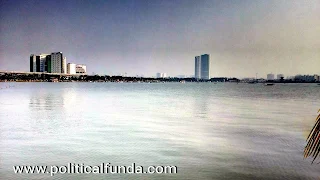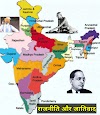What is a body of water?
Body of
water or water body (often spelled water body) is any
significant accumulation of water, generally on a planet's surface. The
term most often refers to, Seas, Oceans, Lakes, but it includes smaller pools
of water such as Ponds, Wetlands, or more rarely, Puddles. A body of water
does not have to be still or contained; Rivers, Streams, Canals,
and others where water moves from one place to another are also considered
bodies of water.
Most are
naturally occurring geographical features, but some are artificial.
Bodies of
water that are navigable are known as waterways. Some bodies of water
collect and move water, such as rivers and streams, and others primarily hold
water, such as lakes and oceans.
The
term body of water can also refer to reservoir of water held by a
plant, technically known as a Phytotelma.
Bodies of
water are affected by gravity which is what creates the tidal effects on
Earth.
Types of Bodies of Water
Water is one of the most important natural resources on earth and
it can be found in various forms on earth.
There are various water bodies which divide into categories of
salt and fresh as well as small and large. Their features differentiate them
from each other. You have must have seen oceans, streams, ponds and more.
All of these are bodies of water only which carry the utmost
importance for life on earth. Let us discuss the different types of bodies of
water in detail for a better understanding.
Bodies of Water
Seas
Lakes
Glaciers
Ocean
However, the way our continents are arranged, it makes it easier
to differentiate between specific ocean basins. Thus, looking at this
distinction, the Pacific Ocean is the largest one. Then we have the Atlantic
Ocean followed by the Indian Ocean.
Finally, we have the Southern Ocean and then the Arctic Ocean.
Mankind is dependent on oceans in various ways, for instance, we get food from
it, use it for transport and also for its impact on the water cycle.
Seas
Humans harnessing and studying the sea have been recorded since
ancient times, and evidenced well into prehistory, while its modern scientific
study is called oceanography.
The word sea is also used to denote second-order sections of the
sea, such as the Mediterranean Sea, as well as certain large, entirely
landlocked, saltwater lakes, such as the Caspian Sea.
The most common example of a sea is the Mediterranean Sea. We also
have other popular ones like the South China Sea, the Caribbean Sea as well as
the Bering Sea. Most of these water bodies directly connect to the ocean.
However, there are particular saline water bodies and the Caspian
Sea is an example of that. Furthermore, it divides into smaller categories of
bays, straits, and gulfs
Lakes
Lakes are distinct from lagoons which are generally coastal parts
of the ocean. They are generally larger and deeper than ponds, which also lie
on land, though there are no official or scientific definitions.
Lakes can be contrasted with rivers or streams, which are usually
flowing in a channel on land. Most lakes are fed and drained by rivers and
streams.
Natural lakes are generally found in mountainous areas, rift
zones, and areas with on-going glaciation. Other lakes are found in endorheic
basins or along the courses of mature rivers, where a river channel has widened
into a basin.
Many lakes are artificial and are constructed for industrial or
agricultural use, for hydro-electric power generation or domestic water supply,
or for aesthetic, recreational purposes, or other activities.
However, lakes can also be quite huge, like the Great Lakes of
North America and Lake Baikal of Russia. Lakes are created from a lot of
procedures, some of which are glacial erosion as well as volcanic eruption in
addition to damming of rivers.
Rivers and Streams
River, Stream
A river is a natural flowing watercourse, usually freshwater,
flowing towards an ocean, sea, lake or another river. Small rivers can be
referred to using names such as stream, creek, brook, rivulet, and rill.
Rivers are quite an important source of water as well as energy.
In addition to that, they are also used greatly for transportation purposes and
as fishing grounds. River Nile in Africa is one of the longest rivers in the
world in addition to the River Amazon in South America. Furthermore, we have
River Mississippi, Congo, Mackenzie and more. more.
Glaciers
Glacier is a persistent body of dense ice that is constantly
moving under its own weight. A glacier forms where the accumulation of snow
exceeds its ablation over many years, often centuries.
Glaciers slowly deform and flow under stresses induced by their
weight, creating crevasses, Seracs, and other distinguishing features. They
also abrade rock and debris from their substrate to create landforms such as
cirques, moraines, or fjords. Glaciers form only on land and are distinct from
the much thinner sea ice and lake ice that forms on the surface of bodies of
water.
Question on
Bodies of Water
Question– Which of the following is the world’s largest ocean?
A. Pacific Ocean
B. Indian Ocean
C. Arctic Ocean
D. Atlantic Ocean
Question- What is the smallest body of water?
Answer- The smallest body of water is the brook,
a natural stream of water that is found aboveground and is often called a creek
as well.
Question- What are the different types of water bodies?
Answer- The different types of water and are as follows;
- Oceans.
- Seas.
- Lakes.
- Rivers and Streams.
- Glaciers.
Also Read










.jpg)




0 Comments